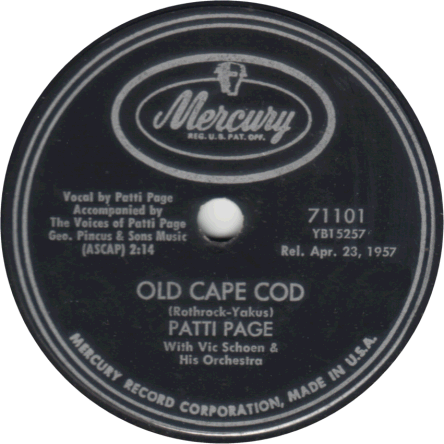
The Beatles
at 78 RPM
|
Cool 78 of the Month February 2009 |
|
Patti Page Old Cape Cod Mercury 71101 (USA) 1978 |

|
|
Twenty years after RCA released the first electrically recorded performances, the industry embarked on a sea of radical changes. Among those where the 45 and LP as compettitors to our freind the 78, but also remarkable changes to the way sound was recorded. As a result of the post World War II technology boom, pioneers began experimenting with recording performances on magnetic tape. Prior to this time a master recording to be used for later mass production was made "direct-to-disk". Les Paul had experimented with overdubbing and multitrack recording in his garage in 1947 using lacquers, often known as acetates. After recording a track on one disk, he could play it back, and then play along with it and create a second disk that combined both performances. Tape recording, however, meant that a high quality master could be made and duplicated with greater ease than ever before. Les Paul's advances in this high-tech of the time, and techniques employed by Mitch Miller, a man who knew pop music but had no love of rock'n'roll, led to the production style used for our cool 78 artist this month, Patti Page. Patti Page was born in 1927 in the American state of Oklahoma. Her real name is Clara Ann Fowler. In 1945 she began singing on a radio show sponsored by the Page Milk Company. At the insistance of the sponsor, her last name was changed to Page for the radio show. No anecdote is recorded as to how her first name Clara Anne was replaced by Patti, but combining the first name Patti with the last name Page sounded as sweet as her voice. She began touring with the Jimmy Joy Band and while in Chicago in 1947 she sang with band leader Benny Goodman's orchestra. Chicago based Mercury Records liked what they heard and offered a contract under the wing of their house producer Mitch Miller. Miller, who is best known for three things, the safe pop sounds that would characterise his days at Columbia records, the TV show Sing Along With Mitch, and an intense dislike of rock'n'roll, would prove to be the man who created Patti's trademark sound. Mitch knew that he had an artist that would be a big hit. He was, however faced with a problem. In 1947 labour troubles at Mercury meant that no backup singers were available for Patti's first record, Confess. Miller hit on the idea that he would have Patti sing along with herself, by playing back a previous take, and in that way she would provide her own harmonies. In doing so Patti Page became the first artist to overdub her own vocals. This would be her trademark sound, and records issued by Mercury would play up the fact by carrying the notation 'Vocals by Patti Page, Patti Page, Patti Page'. It is worth noting that in his 1960's TV show Sing Along With Mitch, Miller would invite the TV audience at home to song along as the words flashed on the screen and a small dot, the bouncing ball, would bounce about the screen encourgaing them to 'follow the bouncing ball' as they did. Confess would become a top 15 hit on Billboard, starting a career that would result in sales of over 100,000,000 records, chart hits in 5 decades, and songs that would become standards such as Tennessee Waltz, I Went to Your Wedding, and (How Much Is That) Doggie in the Window. Her performance of these songs would become the benchmark by which all other versions are measured. In 1957, Patti recorded a wistful song called Old Cape Cod. By this time, Mitch Miller had left Mercury, but Patti continued to record her inimitable style. The label for Old Cape Cod would even note that the vocals were by 'Patti Page accompanied by the voices of Patti Page'! Old Cape Cod is as smooth and lush a cool ocean breeze on summer day. It was a number 7 hit in the USA in July 1957,a nd reached number 4 on the CHUM chart in Canada. Musical styles changed, recording technology evolved, and the 45 and LP did to the 78 what the CD would do to them. A good song is good song forever, and in 1998 the song's smooth relaxing style would impress Andy Cato and Tom Findlay, the guys who made up the duo Groove Armada. The relaxing pop style of artists like Patti Page had given birth to a new type of music called chill-out, with its own unique electronic mellow smooth sound and slow tempo. By sampling Patti's multitracked vocal 'If you're fond of sand dunes and salty air, quaint little villages here and there' and weaving it in and out with their own instrumental composition they created their best known track, the very radio freindly 'At The River'. It is via her recording of Old Cape Cod, best heard on an analog 78, that the first singer to use vocal overdubs, became cool to a whole new generation of music fans who, as children of the digital CD age, probably have no idea what a 78 is! Just as interesting is that an idea from Mitch Miller, a producer who hated rock'n'roll, led to one of chill-out's best known recordings. Next time you listen to it, raise a glass of milk in their honour! |
|
B Side Patti Page Wondering |

|
